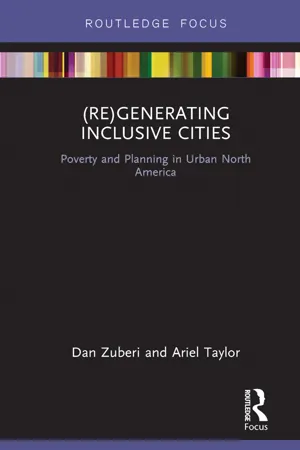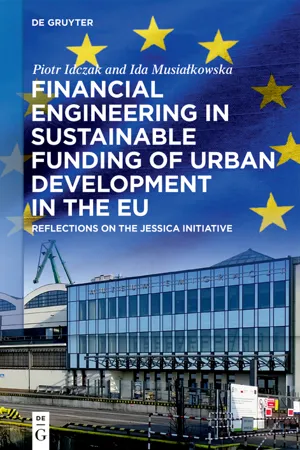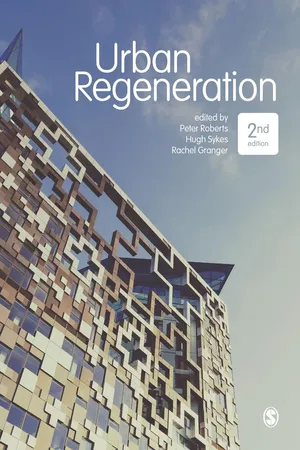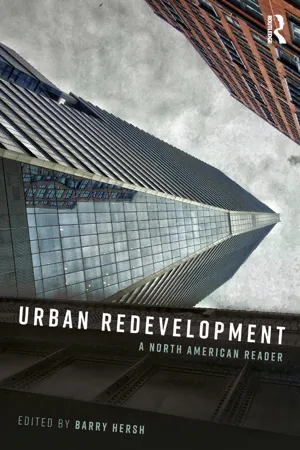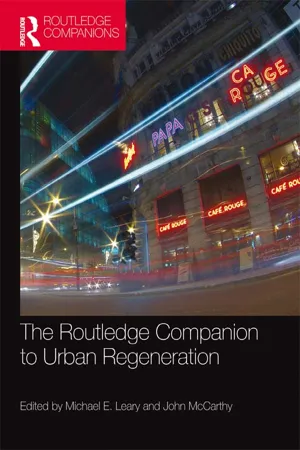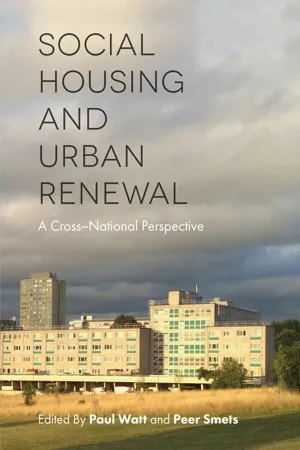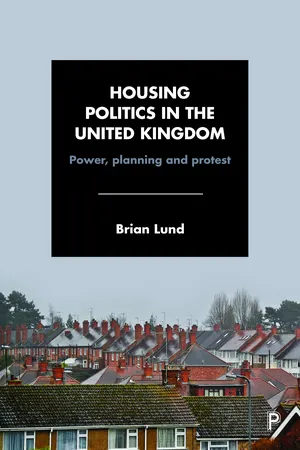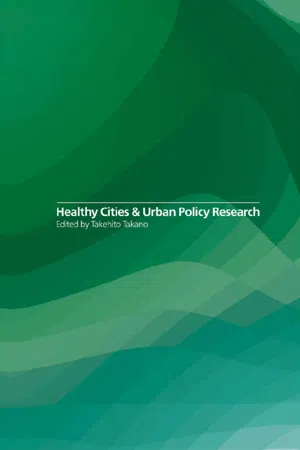Geography
Urban Renewal
Urban renewal refers to the process of revitalizing and improving urban areas, often through the renovation of existing infrastructure, the creation of new public spaces, and the redevelopment of blighted or underutilized areas. It aims to enhance the quality of life for residents, attract investment, and promote economic growth within cities. This process can involve a range of stakeholders, including government agencies, private developers, and community organizations.
Written by Perlego with AI-assistance
Related key terms
10 Key excerpts on "Urban Renewal"
- eBook - ePub
(Re)Generating Inclusive Cities
Poverty and Planning in Urban North America
- Dan Zuberi, Ariel Judith Taylor(Authors)
- 2017(Publication Date)
- Routledge(Publisher)
Introduction Urban Renewal in North America in a Neoliberal ContextCities today are essential economic, cultural and social hubs of global connectivity. As changing political and economic priorities push individuals out of suburban neighborhoods and into urban cores, planners and policy-makers have embraced a variety of strategies to revitalize urban communities. In short, the twin processes of neoliberalism and Urban Renewal have worked to push and pull people into growing cities across North America. This book explores the social-spatial consequences of changing urban landscapes through policies of neoliberal urban regeneration. We pay particular attention to the confluence of urban mega-project development, strategies of residential social mixing, and brownfield cleanup. We contribute to a growing tradition of critical scholarship that seeks to better understand processes of “actually existing neoliberalism”1 by focusing on the socio-spatial dislocation of the urban poor on both sides of the Canadian–American border. Despite historical differences in socioeconomic policy, we find that both countries face mounting socioeconomic pressure associated with urbanization. Gentrification, or the physical displacement of low-income by higher-income populations, is generated through the competitiveness of urban planning under conditions of neoliberal restructuring. However, despite the similarity of outcomes, processes of actually existing gentrification are far from homogenous and in turn open new possibilities for change. We argue the realization of more equitable and livable urban spaces can only be achieved through the inclusive regeneration of democratic urban communities.Urban regeneration is widely understood as a process of socio-spatial change, driven by increased political and economic investment in urban landscapes and supported by heightened rates of urbanization. Once a prominent feature of the North American postwar Fordist economy, processes of urban regeneration have now been transformed under conditions of neo-liberal restructuring. Neoliberalism constitutes both an idea and a set of processes (Jessop 2002; Hackworth 2007; Bridge et al. 2012). Conceptually, neoliberalism is the ideological rejection of egalitarian liberalism as practiced under the Keynesian welfare state. Defined by principles of individualism and laissez-faire economic decision making, neoliberalism embraces principles of market competition and applies them to social life. A rich body of literature spanning the social science disciplines now exists on neoliberalism as a political idea and epistemic phenomenon. However, less well documented are the myriad of often contradictory ways neoliberalism occurs in practice, in communities profoundly shaped by its political, economic and sociological implications. Recent works by Hackworth (2007), Leitner et al. (2007), Purcell (2008), Bridge et al. (2012) and others have attempted to demystify processes of neoliberal urban restructuring and the myriad ways in which urban landscapes are being transformed. - eBook - ePub
Financial Engineering in Sustainable Funding of Urban Development in the EU
Reflections on the JESSICA Initiative
- Piotr Idczak, Ida Musiałkowska(Authors)
- 2022(Publication Date)
- De Gruyter(Publisher)
de Magalhães, 2015 ). Regeneration interventions realise the need to counter localised market failures and to achieve an equity objective (regarded as social cohesion). These actions lead to attaining additional social, economic and environmental outputs and outcomes which would otherwise not have occurred or which would have been yielded at an unsatisfactory level.Of particular importance in this context is a holistic approach. This stipulates that any regeneration initiatives should be implemented by bringing a wide range of social, economic and environmental considerations into the decision-making process on an integrated programme of urban development. The idea considers the regeneration programme as relating to a complete city system, and rejects a piecemeal approach. To address the issues resulting from this comprehensiveness, the needs and aspirations of local residents to redevelop their locality are supposed to be met in the wake of the coordination of a number of private and public sector actions (Couch, Sykes, & Börstinghaus, 2011 ). Moreover, the formulation of solutions to the problems of deprived urban area residents and people living in the neighbourhood should take place by way of a common vision, agreed objectives and priorities, pooled expertise and common decisions for the allocation of resources. In this respect it should also be underlined that, following de Magalhães’s view (2015) , the core understanding of what socio-economic decline in cities means must be seen as social, economic and environmental problems of a city (locality) rather than as social, economic and environmental problems that happened to take place in that locality. Therefore urban regeneration through holistic approach policies seeks to address the problems of cities in all their multiple dimensions. It is then characterised by agendas of inclusiveness, multi-agency partnerships, and a shift from government to governance (J. Evans & Jones, 2008 - eBook - ePub
- Peter Roberts, Hugh Sykes, Rachel Granger, Peter Roberts, Hugh Sykes, Rachel Granger(Authors)
- 2016(Publication Date)
- SAGE Publications Ltd(Publisher)
Having identified and traced the evolution of some of the major issues and factors that have been evident in previous eras of urban change and policy, the preceding section of this chapter isolated six important themes which represent the origins and outcomes of past problems and policy responses. Although they reflect the enduring and continuous nature of economic, social and physical change, they do not yield, by themselves, the basis for a comprehensive definition of urban regeneration. In order to help to construct a working definition of urban regeneration it is also necessary to identify emerging areas of concern and likely future challenges. As was argued above, the most important of these challenges is that which is represented by the need to ensure that all areas of public and private policy operate in accord with the economic, social, environmental and political principles embodied in the notion of sustainable development.A Definition of Urban Regeneration
Although the very nature of regeneration makes it a constantly evolving and varied activity, the six themes provide the basis for an initial definition of urban regeneration as:comprehensive and integrated vision and action which seeks to resolve urban problems and bring about a lasting improvement in the economic, physical, social and environmental condition of an area that has been subject to change or offers opportunities for improvement.This somewhat ideal definition encompasses the essential features of urban regeneration identified by Lichfield, who points to the need for ‘a better understanding of the processes of decline’ and an ‘agreement on what one is trying to achieve and how’ (Lichfield, 1992: 19); by Hausner, who emphasises the inherent weaknesses of approaches to regeneration that are ‘short-term, fragmented, ad hoc and project-based without an overall strategic framework for city-wide development’ (Hausner, 1993: 526); by Donnison in his call for ‘new ways of tackling our problems which focus in a co-ordinated way on problems and on the areas where those problems are concentrated’ (Donnison, 1993: 18); and by Diamond and Liddle (2005) who emphasise the need for action across all relevant policy spheres.The definition given above represents urban regeneration designed and delivered in a total package and to the final point of completion. However, as Tallon (2010) observes, the reality is that regeneration often operates in a fragmented manner and not all problems are solved. - eBook - ePub
- Michael Oxley(Author)
- 2004(Publication Date)
- Bloomsbury Academic(Publisher)
Chapter 9Housing, Planning and Urban RenaissanceIn Chapter 5 it was shown that sustainable development is a key planning objective throughout the world. In advanced economies, and in Europe and America in particular, less urban sprawl and more compact energy-saving residential development have been viewed as important components of this environmental agenda. In this chapter we review ideas about combining compact development with an improved quality of urban living. These have been objectives of ‘urban renaissance’ in Britain and ‘new urbanism’ and ‘smart growth’ in America. The essence of these concepts will be examined, with an emphasis on the aims and instruments of urban renaissance.In Britain, the government-appointed Urban Task Force, in its report Towards an Urban Renaissance (DETR, 1999a), set out a vision for improved urban living. This vision, in which towns and cities provide a high quality of life and accommodate an increased proportion of new housing development, was endorsed by the White Paper Our Towns and Cities: The Future: Delivering an Urban Renaissance (DETR, 2000a). In this chapter the meaning and implications of urban renaissance are reviewed. Three related issues are then be examined: promoting brownfield residential development, the role of urban capacity studies, and the low demand for housing in some urban areas.More development on previously used or brownfield land is now an objective in many advanced countries. In Britain, achieving 60 per cent of future housing development on brownfield sites by redeveloping previously used land and buildings is a key government target. The role of economic policy instruments such as new taxes in promoting this target will be examined, and the connections between economic policy instruments and the planning system will be explored. Urban capacity studies are required to assess how much new housing can be accommodated in towns and cities, and the methodology and the implications of these studies will be examined. In some inner-city neighbourhoods in England urban renaissance has been threatened by low and falling demand for housing; the reasons for this and possible responses will be examined. - eBook - ePub
Urban Redevelopment
A North American Reader
- Barry Hersh, Barry Hersh(Authors)
- 2017(Publication Date)
- Routledge(Publisher)
Urban redevelopment is still at times seen as the old Urban Renewal, removing or damaging existing communities often of color. Leaving urban neighborhoods in poor condition has led to the thought that the only thing worse than gentrification is no gentrification, and some recent studies have suggested that displacement of long-term low-income residents, which is the major concern, may not be as significant as the conventional wisdom suggests. 3 For urban redevelopment to succeed, there must be true community engagement, decision making based upon residents knowledge of what is important to keep and what needs to be replaced. Unlike traditional suburban development, which often aims at one market segment, urban redevelopment almost always aims at providing a range of housing opportunities in terms of type of unit (townhouse, garden apartment, high-rise), ownership (single-family, townhouse, condominium, rental) as well as price, whether rented or owned. Redevelopment may also involve rehabilitation, the improvement of existing housing stock, as well as new construction. Working with a community to provide a range of housing, including for the low income, has become an all but mandatory hallmark of successful modern urban redevelopment, but finding subsidies for affordable housing is challenging. It is also important to note that even a successful redevelopment will not help every person in the community. Programs that focus on individuals, such as for the homeless or for gifted students, and the human part of the equation, are also a key component to real change in a city. Majora Carter, the founder of the non-profit Sustainable South Bronx and a MacArthur award winner, has created parks, supported better air quality and affordable housing and opposed a jail in her Hunt’s Point neighborhood. Served, isolated and environmentally impacted by Urban Renewal era highways Hunts Point is a low-income, minority community dominated by New York City food distribution hub - eBook - ePub
- Michael E. Leary, John McCarthy, Michael E. Leary, John McCarthy(Authors)
- 2013(Publication Date)
- Routledge(Publisher)
2 Emerging reconceptualizations of urban regenerationPassage contains an image
2 Ontroduction
Michael E. LearyDOI: 10.4324/9780203108581-14One complication faced in any discussion of reconceptualizations of urban regeneration is that there is no certainty as to when it first emerged. If the term came into widespread use in the 1980s, there is no doubt that the policy and practice of large-scale state-led intervention in areas of cities suffering from concentrations of problems have a long history going back at least to the mid-nineteenth century. What is clear is that sometime between the 1980s and 1990s in a variety of jurisdictions, traditional wholesale clearance of working class areas through programmes of demolition and redevelopment, often called: Urban Renewal, slum clearance, city reconstruction or comprehensive redevelopment, merged into what we now recognize as urban regeneration. This Part asks some fundamental questions, not least about how and in what ways the concept of urban regeneration tends to change through time and has different meanings or connotations in different national and local contexts. It allows the further interrogation of issues raised in the opening Part of the book, exploring in greater depth how each national context and set of contingent particularities has specific implications for urban regeneration policy, programmes and projects. One of the aims of this Part is to demonstrate how locally based regeneration continually adapts and manoeuvres within the structural constraints and opportunities presented by globalized neo-liberalism discussed in the opening Part of the book. While the analytical focus is on reconceptualization, it should be appreciated that over the decades regeneration is also characterized by continuity and the endurance of certain concepts and assumptions, for example the area-based initiative (ABI) approach and the pathological metaphor discourse as a way of understanding urban problems (Matthews 2010 - eBook - ePub
- Paul Watt, Peer Smets, Paul Watt, Peer Smets(Authors)
- 2017(Publication Date)
- Emerald Publishing Limited(Publisher)
Glynn, 2009 ). The rationale behind these programmes is twofold. First they are thought to improve the outcomes of disadvantaged social housing tenants by enabling them to live in more diverse and tolerant communities, and to take advantage of employment opportunities that arise through their interaction with, or emulation of, their employed neighbours. In addition, Urban Renewal works to ‘clean up’ problematic neighbourhoods, both through the upgrade of the physical environment and by attracting more ‘respectable’ incomers. This is expected to reduce the social problems that beset areas of concentrated disadvantage and shake-off the stigma developed through association with the presence of undesirable or troublesome social housing tenants.In the literature, the creation of socially mixed neighbourhoods has been seen as a step towards neighbourhood gentrification involving the arrival of middle-income groups into low-income areas and the subsequent displacement of the lower-income groups who already reside there (Bridge et al., 2012 ). Where initially thought to be an unfortunate, but unintended, outcome of Urban Renewal, researchers now view this process of gentrification as an active state-led campaign to capitalize on the market value of impoverished inner-city areas by remaking them into desirable places for cosmopolitan middle-class consumers (Lupton & Tunstall, 2008 ; Shaw, 2012 ; van Creikingen, 2012 ; Watt, 2013 ). It is for this reason that Lees (2008) accuses current narratives of social mix as a rhetorical device for masking an explicit gentrification and social cleansing agenda via positive overtones of rendering cities more liveable and sustainable (see also Walks & Maaranen, 2008 ).As the Queensland State Department of Housing and Public Works (DHPW) begins to roll out what has been heralded a ‘radical’ and ‘unprecedented’ (Pawson, Milligan, Wiesel & Hulse, 2013 - David Counsell, Graham Haughton(Authors)
- 2004(Publication Date)
- Routledge(Publisher)
Table 6.1 ). Interestingly, then, urban renaissance is perhaps best regarded as a political strategy and political resource in much the same way as sustainable development. It is a collection of ideas which can be drawn upon selectively by those seeking to advocate particular development approaches.Table 6.1 The urban renaissance agenda in regional planning, as at April 2003Sustainable communities?
In early 2003 the government released its action plan Sustainable Communities: Building for the Future (ODPM 2003a), in the process launching some radical proposals for addressing the twin pressures of urban expansion in the South East and the East of England, and housing abandonment, particularly in northern cities. The action plan proposed new powers to intervene in areas with severe problems of housing abandonment, including the establishment of partnerships of local authorities and other key stakeholders to develop strategic plans for whole housing markets and the creation of nine low-demand pathfinder projects.In addition, it announced the government’s proposals for new housing in the south of the country, drawing on the initial findings of some sub-regional reviews commissioned as part of the regional planning process. Having reduced the proposed number of new households suggested by the South East RPG public examination panel by around 200,000 in RPG9 in 2001 (GOSE 2001), just two years later the government added back 200,000 households to the number of new households it expected to be built by 2016. The political masterstroke was to argue that the sub-regional studies suggested that many new households could be accommodated in four new ‘growth areas’: Thames Gateway, Milton Keynes–South Midlands, London– Stansted–Cambridge, and Ashford in Kent (Figure 6.2 ). In a speech following publication of Sustainable Communities- eBook - ePub
Housing Politics in the United Kingdom
Power, Planning and Protest
- Lund, Brian(Authors)
- 2016(Publication Date)
- Policy Press(Publisher)
Moreover, as Foucault’s ‘governmentality’ idea highlights, some clearance ‘subjects’ seem to have absorbed the dominant discourses on their condition, there being very little bottom-up resistance to clearance and its associated rehousing forms. Thus, it is hardly surprising that in the 1930s’ ‘clearance drive’, the slum inhabitants in clearance areas were never asked directly about their aspirations and were often placed in flats, although public opinion surveys always clearly demonstrated a clear distaste for such accommodation. This paternalistic approach continued throughout the 1950s and 1960s and into the 1970s, augmented by the professional, technical planners – the ‘evangelist bureaucrats’ – who, like Edwin Chadwick in the 19th century, claimed an expertise in the public good unknown to the ordinary man and woman. Resistance developed when clearance areas started to incorporate growing numbers of homeowners.As political attention switched from unfit property to economic regeneration, Michael Heseltine’s Enterprise Zones and Urban Development Corporations were set up to evade local involvement in decision-making, and the new approach, together with the ‘brownfields first’ policy, had some success in kick-starting property-led regeneration. Blair’s New Deal for Communities and the Neighbourhood Renewal Fund had a strong emphasis on community involvement but a large proportion of the resources available to neighbourhoods were allocated outside the programmes, controlled by officials working in the education, health and employment sectors.Urban Renewal has been dominated by the politics involved in the ‘containment of urban England’ (Hall et al, 1973): building flats in inner cities, although contributing to urban renaissance in the 2000s, has also reflected an attempt to restrain suburban expansion and safeguard ‘rural England’. The ‘rural England’ preservers have been well organised, whereas those who had to endure the consequences of conservation have had a muted and dishonoured voice. Middle-class ‘sharp elbows’ and electoral concerns – the quest for the median voter (see Chapters One and Ten ) – favoured urban containment.Further reading
Allen, C. (2008) Housing Market Renewal and Social Class, London: Routledge.Edwards, C. and Imrie, R. (2015) The Short Guide to Urban Policy, Bristol: Policy Press.Hancock, L. and Mooney, G. (2013) ‘“Welfare ghettos” and the “Broken Society”: Territorial Stigmatization in the Contemporary UK’, Housing, Theory and Society - eBook - ePub
- Takehito Takano, Takehito Takano(Authors)
- 2003(Publication Date)
- Routledge(Publisher)
Closing resource cycles Ecosystems thinking emphasises the region as a complex system characterised by flows of energy, nutrients, materials and other resources which include finance and human resources. Working towards closing cycles by integrating flows and minimising waste will promote sustainability at the urban and regional level. The notion of ecological footprinting may assist the process (Rees 1998).- Designing for sustainability There is a growing need for transforming the design of buildings and products to a sustainable future incorporating the principles of sustainability. Similarly the planning and urban design of parts of the whole of cities requires new approaches whether it be new buildings, conservation, the renewal and creation of public space or the retrofitting of areas both within and on the periphery of cities.
- Management, governance and capacity-building Sustainable urban and/or regional management will require a range of tools addressing environmental, social and economic concerns to assist integration of policy and practice. Also required will be a reconsideration of the processes and practices of governance, including the institutional arrangements and capacities of different levels of government and agencies, and the roles and operation of partnerships between public and private sectors, NGOs and citizens. Learning from Agenda 21 processes is crucial to future forms of governance (CEC 1996).
From experience in Europe it is suggested that increasingly the relationships between urban and regional environments and economies will be of over-riding importance. Themes for exploration and development in relation to this identified by Roberts (1995) include:
Index pages curate the most relevant extracts from our library of academic textbooks. They’ve been created using an in-house natural language model (NLM), each adding context and meaning to key research topics.
